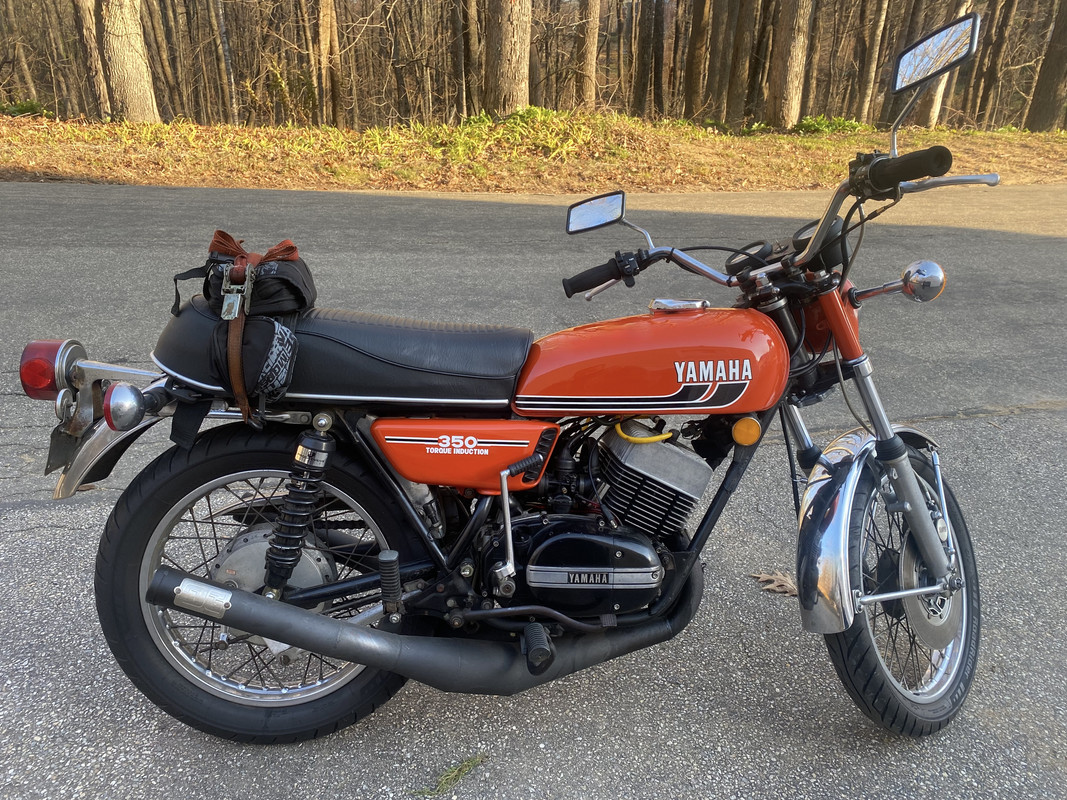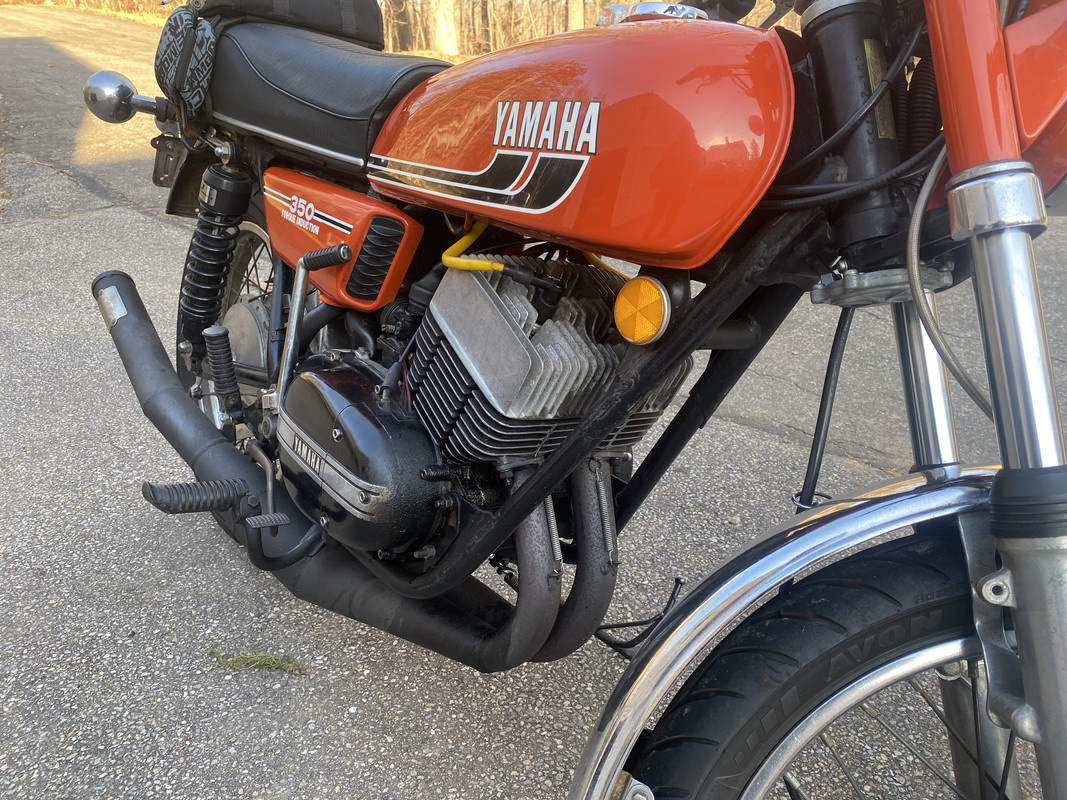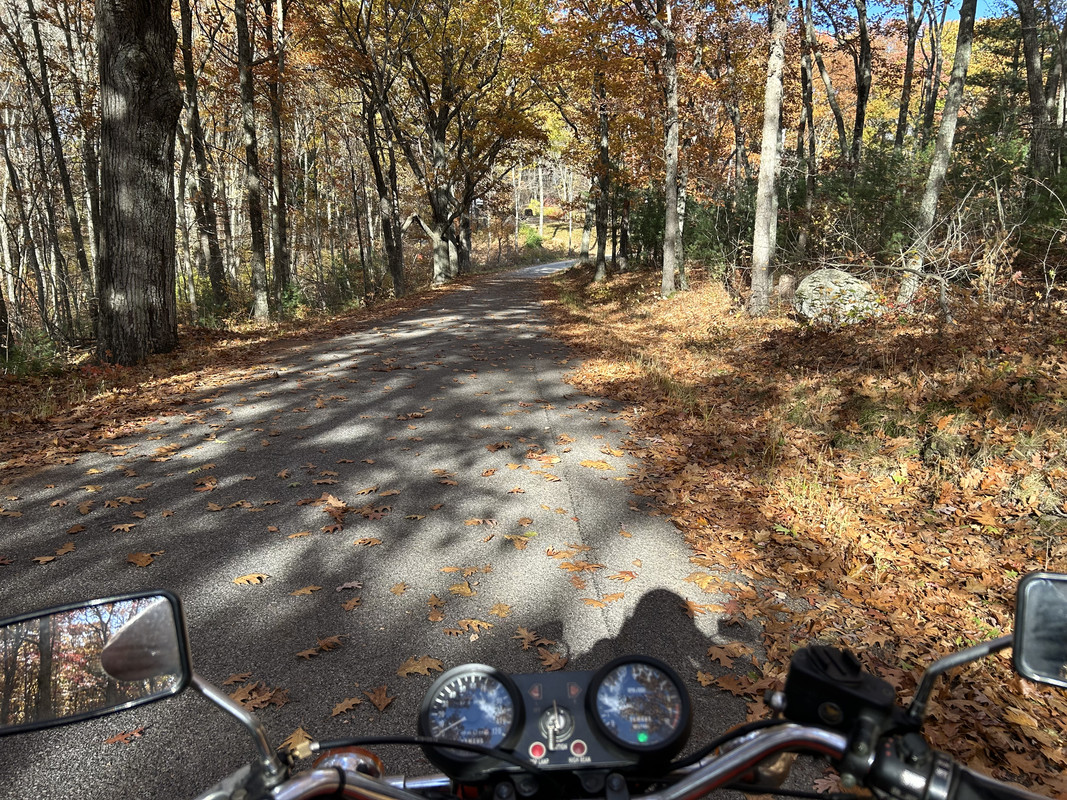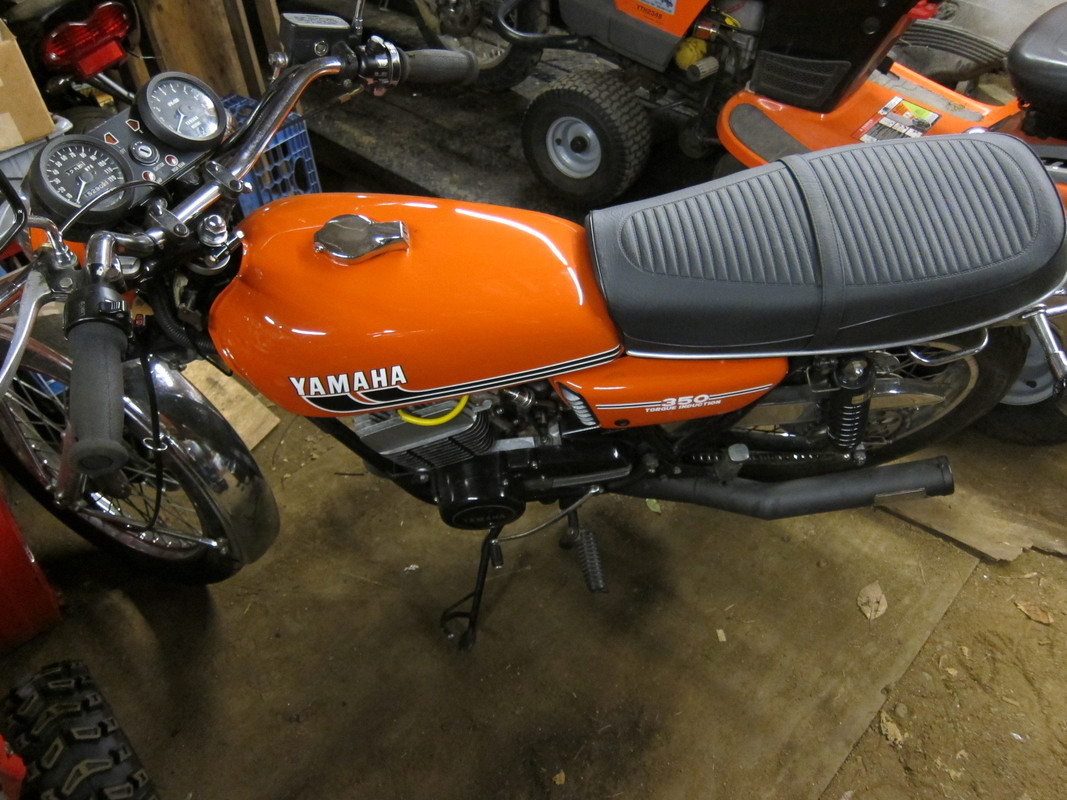You are using an out of date browser. It may not display this or other websites correctly.
You should upgrade or use an alternative browser.
You should upgrade or use an alternative browser.
Export thread
2 stroke longevity - how many hours
#1
J
jkp62
J
jkp62
Bringing this up just for the hell of it : looking over some old posts , and came across this quote : " Your average 4 stroke motor was rated at 500 engine hours, were the 2 stroke motors were rated at 200-250 engine hours of life expectancy before requiring major repair " I`m a big 2 cycle fan . I had a Toro mower with Suzuki motor , from 1989 until 2011 , 5/8 acre , 70 -75 minutes each time . Averaging 26 per season , I figure around 700 hours , and was still running when I sold . I`m thinking my Duraforce Lawn Boys capable of the same . Any thoughts ?
#3

Tiger Small Engine
Tiger Small Engine
It depends, upon a lot of things. How good is the engine to begin with? How is the equipment used and how often? How is the equipment maintained? Sometimes equipment will have a sticker on it with an hour rating. That is how long it is rated to stay within EPA standards. Lucky to get 3-5 years out of a cheap 2-stroke trimmer. Not uncommon for 30-40 year old Stihl chainsaws (2-stroke) to come in the shop.Bringing this up just for the hell of it : looking over some old posts , and came across this quote : " Your average 4 stroke motor was rated at 500 engine hours, were the 2 stroke motors were rated at 200-250 engine hours of life expectancy before requiring major repair " I`m a big 2 cycle fan . I had a Toro mower with Suzuki motor , from 1989 until 2011 , 5/8 acre , 70 -75 minutes each time . Averaging 26 per season , I figure around 700 hours , and was still running when I sold . I`m thinking my Duraforce Lawn Boys capable of the same . Any thoughts ?
#4
R
RevB
R
RevB
Two strokes generally get a bad rap because of oil type and oil mixing issues. A quality air cooled two stroke oil is necessary and the ratio is important as well. As background I've flown two stroke powered Ultralight aircraft for over 30 years. The Rotax guys that didn't have oil injection always thought that more oil in the mix was better.....all they did was shorten the time between overhauls, coke up the top of the pistons, fill the exhaust port with carbon, foul the plugs and lock the rings in place. I went with a 100:1 mix for all my engines, not just UL but trimmers, chain saws, blowers, etc., and the plugs all looked like four stroke engines and never needed to be replaced. Rings stayed free, crosshatch was very visible after 800 hours and no decarbonizing was ever needed. The amount of oil is vanishingly small because of the roller and needle bearings in modern two strokes. If this were a really old plain bearing engine you'd need way more oil in the mix than 100:1 could provide.The brand of 100:1 oil is not important as long as it has a good name behind it. The other advantage in my case was full instrumentation for EGT and CHT. Two strokes do not like getting a too lean mixture. In your case it's simply learning to listen to the engine as you screw in the high speed needle to hear it break over from a four stroke to a two stroke. It's a learned skill that isn't magic, just a practiced ear.
#5

Smithsonite
Smithsonite
Really subjective, since it depends entirely on how the equipment was cared for.
That said, as a lifelong mechanic, my 2-strokes last many times longer than the internet would have you believe. I can tune them by ear (whether it's a chainsaw or string trimmer, or a dirt bike / ATV or my paramotor), and they will all last forever.
I've been trimming my 2.5 acres for 22 years on the same Echo SRM-210 trimmer that has only had 1 carburetor (& fuel lines) and 1 spark plug replacement in that timeframe. I'm not gentle on any of my engines - they're there to get the job done as fast as possible. Around my yard it sees everything from low-RPM, light load trimming to full-throttle, chernobyl-temperature "brushhogging" through foot tall grass in the middle of July. Every time I use it I go through a full tank. Sometimes more. I'd wager it will still have well over 100 PSI compression ice cold.
Everything gets mixed with Amsoil Saber at 100:1, except the paramotor. That gets mixed at 66:1 (that was a number a more experienced instructor said he used for his paramotor school rigs for many years with success down in smoking hot LA, so that's what I've been using).
The paramotor has about 30 hours on it, but during climb out, I regularly nudge 400° cylinder head temps.




Oh, and another 2-stroke I forgot to mention. This one has 7k+ miles on it since a complete overhaul. Still runs like the day I first started it. Starts 3 kicks cold whether it sat for 8 hours or 8 months, and always 1 kick warm.
This one gets Amsoil Dominator since it's oil injected. I feel Saber is a bit too heavy for the injection pump and could cause issues.





That said, as a lifelong mechanic, my 2-strokes last many times longer than the internet would have you believe. I can tune them by ear (whether it's a chainsaw or string trimmer, or a dirt bike / ATV or my paramotor), and they will all last forever.
I've been trimming my 2.5 acres for 22 years on the same Echo SRM-210 trimmer that has only had 1 carburetor (& fuel lines) and 1 spark plug replacement in that timeframe. I'm not gentle on any of my engines - they're there to get the job done as fast as possible. Around my yard it sees everything from low-RPM, light load trimming to full-throttle, chernobyl-temperature "brushhogging" through foot tall grass in the middle of July. Every time I use it I go through a full tank. Sometimes more. I'd wager it will still have well over 100 PSI compression ice cold.
Everything gets mixed with Amsoil Saber at 100:1, except the paramotor. That gets mixed at 66:1 (that was a number a more experienced instructor said he used for his paramotor school rigs for many years with success down in smoking hot LA, so that's what I've been using).
The paramotor has about 30 hours on it, but during climb out, I regularly nudge 400° cylinder head temps.




Oh, and another 2-stroke I forgot to mention. This one has 7k+ miles on it since a complete overhaul. Still runs like the day I first started it. Starts 3 kicks cold whether it sat for 8 hours or 8 months, and always 1 kick warm.
This one gets Amsoil Dominator since it's oil injected. I feel Saber is a bit too heavy for the injection pump and could cause issues.





#6
M
mcspeed
M
mcspeed
I have a 20 year old Stihl line trimmer that works well. Was used heavily on a mountain bike trail building project for 5 years. Now maintains my 3/4 acres and occasionally the HOA common area. It’s been used hard in triple digit temps and has has a carbide table saw blade for trimming saplings and branches…..maybe abused is a better word LOL.
If you buy good quality, it will last. The junk sold in big box stores will not last.
If you buy good quality, it will last. The junk sold in big box stores will not last.
#7
S
srwa
S
srwa
Can't believe what I'm reading concerning the 2 stroke engine. In my extremely humble opinion the 2 cycle came right outta the pit of hell. And to fly using a 2 stroke I would need 4 parashots.
Have to admit my Stihl 026 chainsaw, over 25 years old, still starts on the first to 3rd. pull. The Germans know how to build stuff.
The oil to fuel ratio is critical in a 2 cycle.......and DO NOT leave the fuel mixture in the machine for an extended period.
Had a Ryobi 4cycle weed eater that would cut down a redwood tree. Lasted over 25 years. And, if I treated a human as bad as I treated that weed eater I'd still be in jail.
Have to admit my Stihl 026 chainsaw, over 25 years old, still starts on the first to 3rd. pull. The Germans know how to build stuff.
The oil to fuel ratio is critical in a 2 cycle.......and DO NOT leave the fuel mixture in the machine for an extended period.
Had a Ryobi 4cycle weed eater that would cut down a redwood tree. Lasted over 25 years. And, if I treated a human as bad as I treated that weed eater I'd still be in jail.
#8

Smithsonite
Smithsonite
They are the simplest, lightest, cheapest, and most powerful engines for their size. Zero downsides in my eyes. As a mechanic, I wish everything I owned was a 2-stroke, even the cars and truck! A V8 2-stroke would be an absolute powerhouse.
#9
R
RevB
R
RevB
You want a Detroit 12v-71T diesel. But if stuck in a V8 then a 8V-71TA or TTA.They are the simplest, lightest, cheapest, and most powerful engines for their size. Zero downsides in my eyes. As a mechanic, I wish everything I owned was a 2-stroke, even the cars and truck! A V8 2-stroke would be an absolute powerhouse.
#10
M
mcspeed
M
mcspeed
I have a John Deere chain saw I bought new over 40 years ago. Never drained the fuel or used additive. Starts and runs like new.Can't believe what I'm reading concerning the 2 stroke engine. In my extremely humble opinion the 2 cycle came right outta the pit of hell. And to fly using a 2 stroke I would need 4 parashots.
Have to admit my Stihl 026 chainsaw, over 25 years old, still starts on the first to 3rd. pull. The Germans know how to build stuff.
The oil to fuel ratio is critical in a 2 cycle.......and DO NOT leave the fuel mixture in the machine for an extended period.
Had a Ryobi 4cycle weed eater that would cut down a redwood tree. Lasted over 25 years. And, if I treated a human as bad as I treated that weed eater I'd still be in jail.
#11

Tiger Small Engine
Do not mix oil to fuel at anything except 50:1. You can do your research. You can argue. You can disagree. 50:1 is what is recommended.
If taken care of, two stroke equipment will last many years, especially if it is quality brand to start with.
Tiger Small Engine
Two strokes are louder, and smoke. Those are probably the two main reasons that many manufacturers have gotten away from them a lot.Two strokes generally get a bad rap because of oil type and oil mixing issues. A quality air cooled two stroke oil is necessary and the ratio is important as well. As background I've flown two stroke powered Ultralight aircraft for over 30 years. The Rotax guys that didn't have oil injection always thought that more oil in the mix was better.....all they did was shorten the time between overhauls, coke up the top of the pistons, fill the exhaust port with carbon, foul the plugs and lock the rings in place. I went with a 100:1 mix for all my engines, not just UL but trimmers, chain saws, blowers, etc., and the plugs all looked like four stroke engines and never needed to be replaced. Rings stayed free, crosshatch was very visible after 800 hours and no decarbonizing was ever needed. The amount of oil is vanishingly small because of the roller and needle bearings in modern two strokes. If this were a really old plain bearing engine you'd need way more oil in the mix than 100:1 could provide.The brand of 100:1 oil is not important as long as it has a good name behind it. The other advantage in my case was full instrumentation for EGT and CHT. Two strokes do not like getting a too lean mixture. In your case it's simply learning to listen to the engine as you screw in the high speed needle to hear it break over from a four stroke to a two stroke. It's a learned skill that isn't magic, just a practiced ear.
Do not mix oil to fuel at anything except 50:1. You can do your research. You can argue. You can disagree. 50:1 is what is recommended.
If taken care of, two stroke equipment will last many years, especially if it is quality brand to start with.
#12
R
RevB
R
RevB
And before 50:1 it was 20:1 with plain motor oil, then it went to 25:1, then 30:1 with castor oil, then 40:1 with specially formulated two stroke oil that served both water and air cooled. Then 40:1 with oils specifically formulated for water or air cooled. Then 50:1......and then everything stopped. No more progress. Oils couldn't get any better so they quit. Same for metalurgy and bearings. Everybody just gave up.Two strokes are louder, and smoke. Those are probably the two main reasons that many manufacturers have gotten away from them a lot.
Do not mix oil to fuel at anything except 50:1. You can do your research. You can argue. You can disagree. 50:1 is what is recommended.
If taken care of, two stroke equipment will last many years, especially if it is quality brand to start with.
#13
S
srwa
I was born in March of 37......1937.............do the math.
S
srwa
I'm a "touch prejudice" regarding 2 cycles. First "run in" with them was in the late 40's early 50's. Was not a good experience.I have a John Deere chain saw I bought new over 40 years ago. Never drained the fuel or used additive. Starts and runs like new.
I was born in March of 37......1937.............do the math.
#14
G
GearHead36

I've had good luck with 2-strokes. I raced 2-stroke dirt bikes in the 70's. Since then, I've had numerous 2-stroke trimmers, leaf blowers, chainsaws, etc. I'm just a homeowner, and I've never operated a 2-stroke engine commercially, but I've never had one die. For power equipment that I'm carrying (chainsaw, trimmer, etc), it's 2-stroke all the way for me. They're lighter than their 4-stroke counterparts for the same power, so I can carry it longer, and get more work done.
Now my riding mower is different. It has a 27hp EFI engine, and two 3.5gal fuel tanks. It takes 2 hrs to mow my yard, and I can mow it at least 3 times on that much fuel. If it were a 2-stroke, it would probably use all 7 gallons each mow.
Are 2-strokes fragile, temperamental, finicky? I don't think so. Maybe slightly more than a 4-stroke, but if maintained, both will be reliable. If ethanol fuel is left in them over the Winter, it won't matter whether it's a 2 or 4-stroke. Neither will start, and both will need a carb cleaning or rebuild. In 2011, I bought a mower with a B&S flathead engine, and an Echo 225 PAS system. I liked the Echo PAS system because it meant only one engine to maintain for all my handheld OPE. It also meant that there wasn't any piece of equipment that didn't get started for weeks. The Echo has been run, I'd say, about 75% as much as the B&S, and they both still run like new today, 14 yrs later.
G
GearHead36
Yeah, but they would get 3 mpg.As a mechanic, I wish everything I owned was a 2-stroke, even the cars and truck!
I've had good luck with 2-strokes. I raced 2-stroke dirt bikes in the 70's. Since then, I've had numerous 2-stroke trimmers, leaf blowers, chainsaws, etc. I'm just a homeowner, and I've never operated a 2-stroke engine commercially, but I've never had one die. For power equipment that I'm carrying (chainsaw, trimmer, etc), it's 2-stroke all the way for me. They're lighter than their 4-stroke counterparts for the same power, so I can carry it longer, and get more work done.
Now my riding mower is different. It has a 27hp EFI engine, and two 3.5gal fuel tanks. It takes 2 hrs to mow my yard, and I can mow it at least 3 times on that much fuel. If it were a 2-stroke, it would probably use all 7 gallons each mow.
Are 2-strokes fragile, temperamental, finicky? I don't think so. Maybe slightly more than a 4-stroke, but if maintained, both will be reliable. If ethanol fuel is left in them over the Winter, it won't matter whether it's a 2 or 4-stroke. Neither will start, and both will need a carb cleaning or rebuild. In 2011, I bought a mower with a B&S flathead engine, and an Echo 225 PAS system. I liked the Echo PAS system because it meant only one engine to maintain for all my handheld OPE. It also meant that there wasn't any piece of equipment that didn't get started for weeks. The Echo has been run, I'd say, about 75% as much as the B&S, and they both still run like new today, 14 yrs later.
#16
G
GearHead36
G
GearHead36
OK, but that RD weighs (according to Wikipedia) 342lbs. A truck weighs over 10X that. Although I have to say, that must be a VERY well tuned RD. My 4-stroke bikes never got mileage that good.My RD350 consistently gets 38 MPG. I spent a LOT of time tuning.
#17

Smithsonite
Smithsonite
It also has MANY modifications. Carb mods, reeds, porting, pipes, higher compression, different pistons, crank balanced, etc.. I got the squish set within .001" of where I wanted it, and run the timing advanced farther than anyone else with the same bike dares. Runs absolutely perfect. I figure around 70HP at the crank, maybe more. She rips!
#18
D
dana a
D
dana a
That would be a little too big and heavy for a lawn mower. I put a 3-71 Detroit in a chevy crewcab and it was very heavy in the front. Later I swapped in a 4-53T with a 5 speed and 3 speed auxilary. Currently I'm running an F150 with a 4BT Cummin and that is perfect.You want a Detroit 12v-71T diesel. But if stuck in a V8 then a 8V-71TA or TTA.
#19
A
Auto Doc's
It's all about proper fuel/oil mixture and fixing the little things before they get out of hand. I use non-Ethanol fuel in my mix.
A
Auto Doc's
I've got some 40-year-old 2-stroke equipment that I can still rely on.Bringing this up just for the hell of it : looking over some old posts , and came across this quote : " Your average 4 stroke motor was rated at 500 engine hours, were the 2 stroke motors were rated at 200-250 engine hours of life expectancy before requiring major repair " I`m a big 2 cycle fan . I had a Toro mower with Suzuki motor , from 1989 until 2011 , 5/8 acre , 70 -75 minutes each time . Averaging 26 per season , I figure around 700 hours , and was still running when I sold . I`m thinking my Duraforce Lawn Boys capable of the same . Any thoughts ?
It's all about proper fuel/oil mixture and fixing the little things before they get out of hand. I use non-Ethanol fuel in my mix.
#20
D
Douglas Lee
D
Douglas Lee
So . . . are you saying with an older (25 + years old ) chain saw, it's ok to run it with a 100:1
fuel mixture verses the 16:1 suggested by the manufacturer?
Thanks,
Doug Lee
*
fuel mixture verses the 16:1 suggested by the manufacturer?
Thanks,
Doug Lee
*
#22
G
GearHead36
I'm with the "it depends on how it was cared for" crowd. If you use E0 and a high quality oil (I used Echo Red Armor, which has fuel stabilizer), the diaphragms will likely last for multiple decades. If you keep the air filter clean, the exhaust screen clear, it will work for decades. You might have to replace fuel lines every 10 yrs or so, but maybe not. I have 15 yr old equipment with the original fuel lines.
G
GearHead36
Where are you getting 100:1? Most modern equipment recommend 50:1. For the old chainsaw mentioned, I'd probably go with 40:1. The oils today ARE better than what was available 25 yrs ago.So . . . are you saying with an older (25 + years old ) chain saw, it's ok to run it with a 100:1
fuel mixture verses the 16:1 suggested by the manufacturer?
Thanks,
Doug Lee
*
I'm with the "it depends on how it was cared for" crowd. If you use E0 and a high quality oil (I used Echo Red Armor, which has fuel stabilizer), the diaphragms will likely last for multiple decades. If you keep the air filter clean, the exhaust screen clear, it will work for decades. You might have to replace fuel lines every 10 yrs or so, but maybe not. I have 15 yr old equipment with the original fuel lines.
#23

Smithsonite
Smithsonite
I've run 100:1 in saws 40 years old. ONLY with Amsoil Saber, though. I wouldn't dare do it with much else ... aside from maybe one other brand whose name escapes me at the moment ...
#24

Tiger Small Engine
Tiger Small Engine
Anyone that runs 100:1 in anything, old or new, is crazy. I read about it all the time online, and am not disputing that people do it. I am just saying as inexpensive as oil is, why?I've run 100:1 in saws 40 years old. ONLY with Amsoil Saber, though. I wouldn't dare do it with much else ... aside from maybe one other brand whose name escapes me at the moment ...
#26
G
GearHead36
"If this were a really old plain bearing engine you'd need way more oil in the mix than 100:1 could provide."
G
GearHead36
Post #4 also mentions:Post #4 is talking about a 100:1 mixture!
Thanks,
Douglas Lee
*
"If this were a really old plain bearing engine you'd need way more oil in the mix than 100:1 could provide."
#27

Smithsonite
As I mentioned many posts ago, I've been running the same Echo SRM-210 trimmer on it since 2003, trimming 2.5 acres of land, and going through a minimum of 1 tank per use (sometimes 2).
I ran a small engine & auto repair shop for 14 years, and used it at 100:1 in all my customer's equipment. Never once have I seen a failure due to that ratio. In fact, I've been impressed by what I've seen inside on extremely abused equipment. There is almost zero carbon buildup, saving you from maintenance of cleaning ports, scraping pistons, and cooking mufflers clean, plus the oil has a fuel stabilizer. I ask, why WOULDN'T you use it at the recommended ratios (80 or 100:1).
Also many posts back, I mentioned I use it in my paramotor at 66:1.
Amsoil is as good as it gets when it comes to lubricants. And NO, it is NOT cheap. Quality rarely is.
But, everyone is free to do as they wish - it's their money.
Smithsonite
If it works, why not?Anyone that runs 100:1 in anything, old or new, is crazy. I read about it all the time online, and am not disputing that people do it. I am just saying as inexpensive as oil is, why?
As I mentioned many posts ago, I've been running the same Echo SRM-210 trimmer on it since 2003, trimming 2.5 acres of land, and going through a minimum of 1 tank per use (sometimes 2).
I ran a small engine & auto repair shop for 14 years, and used it at 100:1 in all my customer's equipment. Never once have I seen a failure due to that ratio. In fact, I've been impressed by what I've seen inside on extremely abused equipment. There is almost zero carbon buildup, saving you from maintenance of cleaning ports, scraping pistons, and cooking mufflers clean, plus the oil has a fuel stabilizer. I ask, why WOULDN'T you use it at the recommended ratios (80 or 100:1).
Also many posts back, I mentioned I use it in my paramotor at 66:1.
Amsoil is as good as it gets when it comes to lubricants. And NO, it is NOT cheap. Quality rarely is.
But, everyone is free to do as they wish - it's their money.
#29
A
Auto Doc's
A
Auto Doc's
I don't think too many folks are going to rush right out and order Amsoil for their modern throw away 2-stroke just so they can conduct a private study.
#30
D
dana a
D
dana a
I was curious about how you determine what ratio to use in various piece of equipment. You mentioned 100, 80 and 66 to oneIf it works, why not?
As I mentioned many posts ago, I've been running the same Echo SRM-210 trimmer on it since 2003, trimming 2.5 acres of land, and going through a minimum of 1 tank per use (sometimes 2).
I ran a small engine & auto repair shop for 14 years, and used it at 100:1 in all my customer's equipment. Never once have I seen a failure due to that ratio. In fact, I've been impressed by what I've seen inside on extremely abused equipment. There is almost zero carbon buildup, saving you from maintenance of cleaning ports, scraping pistons, and cooking mufflers clean, plus the oil has a fuel stabilizer. I ask, why WOULDN'T you use it at the recommended ratios (80 or 100:1).
Also many posts back, I mentioned I use it in my paramotor at 66:1.
Amsoil is as good as it gets when it comes to lubricants. And NO, it is NOT cheap. Quality rarely is.
But, everyone is free to do as they wish - it's their money.
#31

Smithsonite
Smithsonite
80 & 100 are recommended by Amsoil right on the bottle - they leave it up to you to decide. They stake their reputation on it. Some people aren't comfortable with either and mix at 50:1 - that's fine - it's your money as I said. If you want to use double the necessary oil, totally fine.
Same with their 4-stroke engine oils and their 25k recommended changes. That's a different ballgame in the 21st century, so I won't get into that here ( long and short, I'd do that on my '86 Grand Marquis, but no chance in hell anything built after 1994).
66, as I mentioned way back in this thread, was used by a paramotor instructor from LA (NOT L.A.) for years on MANY different units in a training environment - in other words, he's tested, tested, and retested that with zero I'll effects. If it can handle the heat down there, I figure that's good enough up here for me in MA.
Same with their 4-stroke engine oils and their 25k recommended changes. That's a different ballgame in the 21st century, so I won't get into that here ( long and short, I'd do that on my '86 Grand Marquis, but no chance in hell anything built after 1994).
66, as I mentioned way back in this thread, was used by a paramotor instructor from LA (NOT L.A.) for years on MANY different units in a training environment - in other words, he's tested, tested, and retested that with zero I'll effects. If it can handle the heat down there, I figure that's good enough up here for me in MA.
#32

Tiger Small Engine
Tiger Small Engine
I have seen Amsoil at trade shows over the years. Even had a guy that came by my house about 25 years ago selling Amsoil. I realize it is a “premium “ product. I wonder what percentage of the 2-stroke oil market Amsoil has? I bet it isn’t much. I wouldn’t mix gold at 100:1.80 & 100 are recommended by Amsoil right on the bottle - they leave it up to you to decide. They stake their reputation on it. Some people aren't comfortable with either and mix at 50:1 - that's fine - it's your money as I said. If you want to use double the necessary oil, totally fine.
Same with their 4-stroke engine oils and their 25k recommended changes. That's a different ballgame in the 21st century, so I won't get into that here ( long and short, I'd do that on my '86 Grand Marquis, but no chance in hell anything built after 1994).
66, as I mentioned way back in this thread, was used by a paramotor instructor from LA (NOT L.A.) for years on MANY different units in a training environment - in other words, he's tested, tested, and retested that with zero I'll effects. If it can handle the heat down there, I figure that's good enough up here for me in MA.
#33
R
RevB
R
RevB
Consistently 50+ mpg on a Yamaha FJR1300aOK, but that RD weighs (according to Wikipedia) 342lbs. A truck weighs over 10X that. Although I have to say, that must be a VERY well tuned RD. My 4-stroke bikes never got mileage that good.
#34
R
RevB
My guess is that anyone recommending 16:1 was specifying plain 30wt motor oil for whatever reason. Could have been castor but kinda doubt it. Lubrication technologies have moved so far from their beginnings. Most think that if a little is good a whole lot of oil is better. Ball bearings at high speeds will skid in the race if given too much lubrication, the hydrodynamic wedge prevents them from turning and that is dependent on Saybolt range of the lubricant. But that's usually a racing problem unrelated to your question.
If the saw has ball and needle bearings, yeah, I'd run an oil that is engineered for 100:1 at maybe 80:1 if you're nervous about 100:1. Scary, isn't it.
R
RevB
Are the bearings plain or ball? Ball bearings were introduced sometime in the 1920s to 1930s...you have to do a patent search to see who claimed to be first or at least had the idea. Needle bearings came along later in the 1930s and40s.So . . . are you saying with an older (25 + years old ) chain saw, it's ok to run it with a 100:1
fuel mixture verses the 16:1 suggested by the manufacturer?
Thanks,
Doug Lee
*
My guess is that anyone recommending 16:1 was specifying plain 30wt motor oil for whatever reason. Could have been castor but kinda doubt it. Lubrication technologies have moved so far from their beginnings. Most think that if a little is good a whole lot of oil is better. Ball bearings at high speeds will skid in the race if given too much lubrication, the hydrodynamic wedge prevents them from turning and that is dependent on Saybolt range of the lubricant. But that's usually a racing problem unrelated to your question.
If the saw has ball and needle bearings, yeah, I'd run an oil that is engineered for 100:1 at maybe 80:1 if you're nervous about 100:1. Scary, isn't it.
#35
R
RevB
And generally price is not the driver. Do the rings stay free? Do you have to decarbon routinely? Do the plug(s) routinely foul? Is the exhaust port staying free of carbon? If the answer is no.....
Had an Ultralight with a 50hp Hirth 2704 running 100:1. Doing that is serious stuff. It's not just being inconvenienced by oil caused problems, it's landing out somewhere where there isn't a landing strip, or road, or clearing. At 400+ hours there was zero carbon on the pistons, none in the exhaust ports, the plugs were still the originals and they looked like a four stroke plug...nice and tan at the porcelain tip running to just a bit darker down into the shell.
Scarey, ain't it.
R
RevB
You mean "premium" as in price? Well, if you're using less per gallon of gas, but you'd need 2x+ as much of the other stuff....is the price per gallon of gas the same or less.I have seen Amsoil at trade shows over the years. Even had a guy that came by my house about 25 years ago selling Amsoil. I realize it is a “premium “ product. I wonder what percentage of the 2-stroke oil market Amsoil has? I bet it isn’t much. I wouldn’t mix gold at 100:1.
And generally price is not the driver. Do the rings stay free? Do you have to decarbon routinely? Do the plug(s) routinely foul? Is the exhaust port staying free of carbon? If the answer is no.....
Had an Ultralight with a 50hp Hirth 2704 running 100:1. Doing that is serious stuff. It's not just being inconvenienced by oil caused problems, it's landing out somewhere where there isn't a landing strip, or road, or clearing. At 400+ hours there was zero carbon on the pistons, none in the exhaust ports, the plugs were still the originals and they looked like a four stroke plug...nice and tan at the porcelain tip running to just a bit darker down into the shell.
Scarey, ain't it.
